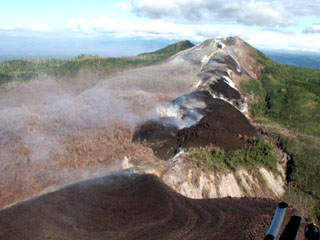Report on Witori (Papua New Guinea) — April 2004
Bulletin of the Global Volcanism Network, vol. 29, no. 4 (April 2004)
Managing Editor: Edward Venzke.
Edited by Richard L. Wunderman. Research and preparation by Don Gruber.
Witori (Papua New Guinea) Recharacterization of reported 24 February eruptive activity
Please cite this report as:
Global Volcanism Program, 2004. Report on Witori (Papua New Guinea) (Wunderman, R.L., and Venzke, E., eds.). Bulletin of the Global Volcanism Network, 29:4. Smithsonian Institution. https://doi.org/10.5479/si.GVP.BGVN200404-252080
Witori
Papua New Guinea
5.5745°S, 150.5161°E; summit elev. 724 m
All times are local (unless otherwise noted)
A message in mid-April from Rabaul Volcano Observatory's assistant director, Ima Itikarai, to Dan Shackelford indicated that their previous Pago report (BGVN 29:02), which noted two eruptions on 24 February 2004, was no longer believed to be true. Described activity, especially felt tremors, contradicted instrumental data. After discussions with local observers Itikarai concluded that "the reported activity may not be true." Although no explanation was given for the reports of ashfall or glow, the message noted that the "jet-like noises" may have been low-frequency sounds from local thunderstorms.
RVO reports for 15 March-1 April noted that Pago's volcanic and seismic activity remained at low levels. All vents gently released small volumes of 'thin white vapor,' with small amounts of 'blue vapor' from the lower vents on some days. A dull glow was observed on 17 March.
Geological Summary. The active Pago cone has grown within the Witori caldera (5.5 x 7.5 km) on the northern coast of central New Britain contains the active Pago cone. The gently sloping outer caldera flanks consist primarily of dacitic pyroclastic-flow and airfall deposits produced during a series of five major explosive eruptions from about 5,600 to 1,200 years ago, many of which may have been associated with caldera formation. Pago cone may have formed less than 350 years ago; it has grown to a height above the caldera rim, and a series of ten dacitic lava flows from it covers much of the caldera floor. The youngest of these was erupted during 2002-2003 from vents extending from the summit nearly to the NW caldera wall. The Buru caldera cuts the SW flank.
Information Contacts: Ima Itikarai and Herman Patia, Rabaul Volcano Observatory, Papua New Guinea.

